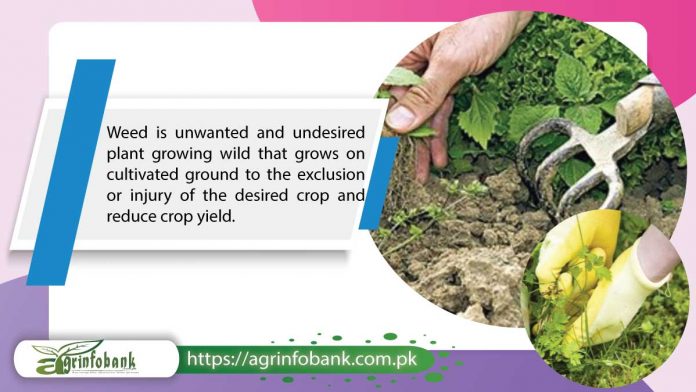Weed is unwanted and undesired plant growing wild that grows on cultivated ground to the exclusion or injury of the desired crop and reduce crop yield. Some weed are propagate with seed and are apart from seed like stem or roots. Annual weeds that complete their life cycle in one season or year or live only 1 year are called as annual weeds. These weeds species reproduce by seeds and spread through dispersal of seeds. The factors that control seed dispersal, seed production, and seed survival may influence the weed population.
Muhammad Talha yasin and Dr. Muhammad Yasin
Department of Agricultural Extension, College of Agriculture
University of Sargodha, Pakistan
Perennial weed complete life cycle in two years .Perennial weeds are propagate vegetatively that include rhizomes, tubers, bulbs, corms, roots, and stems. Weed control is that the botanical component of pest control, improve visibility along forest roads, control noxious weeds, and improve wildlife habitats. The goal is to manage timber species, ground vegetation, and wildlife so as that each component is maximized yet balanced. Its including domesticated plants and livestock, and in natural settings preventing non native species competing with native species. Weed management includes prevention and control weeds by regulated use, restricting invasion, suppression of growth, prevention of seed production , complete destruction and use different weeds control methods.
Cultural control is that the modification of production practices to create the environment less favorable for weeds reproduction, survival and dispersal. Reduced row spacing that the crop can reach canopy more quickly to shade out weeds no sunlight reached on weeds .Crop rotation is best way to forestall weeds from adapting to the weed control tactics common in anyone crop. Nutrient management weeds to not allow optimum amount of nutrients crop uptake while denying weeds access to nutrients. Cover crops to compete with weeds for space, sunlight, nutrients, and water. Mechanical control consists of methods that kill weeds through physicaly.The methods include pulling, disking, digging , plowing and mowing. Success of assorted mechanical control methods depends on the life cycle of the target weed species. Many gardeners still remove weeds by manually pulling them out of the ground, making sure to include the roots that would otherwise allow some to re-sprout. Digging are effective on annual and biennial species. it’s important to get rid of 2-3 inches of upper parts of taproot to stop re-growth of weeds. Digging a perennial weed like spurge is a futile effort unless one has the time necessary to diligently dig or pull re-growth over several seasons. Shallow tillage with a disk or sweep is effective for controlling annual species. Perennial root systems often have meristematic buds which will set roots and produce a brand new plant from root segments deposited on the soil surface. Shallow tillage of perennial weeds may end up in an exceedingly larger, denser and more uniform .Moldboard plowing complete turnover of the highest 10-12 inches of soil. Mowing could be a suppression measure which will decrease seed head production. Mowed weeds will re-grow and set seed from a reduced height, so a combined control method is important to be effective. Chemical weed control refers technique that involves the applying of a chemical to weeds and soil to regulate the germination or growth of the various weed species. Buried drip irrigation involves burying drip tape in the subsurface near the planting bed, thereby limiting weeds access to water while also allowing crops to obtain moisture. It is most effective during dry periods. Chemical weed control, chemicals are used is named herbicides that’s are accustomed kill to focus on plants or inhibit their growth. Biological weed control involves using living organisms, like insects, nematodes, bacteria, or fungi, to cut back weed populations. Biological control method can reduce weeds but it’s out of the question to eradicate weeds. Biological Control Agents Insects are most often used as biological control agents of weeds and this can likely continue. Biological control agents are selected very carefully. A study is meted out overseas to spot all the organisms found attacking a weed.
Why control weed
· Prevent yield loss because of weed competition
· Maintain purity ,quality and value of harvested grain
· Prevent build-up of weed seeds in soil
· Prevent weeds which will attract insects or rodents (rats) or act as a bunch for diseases
· Prevent clogging of field irrigation channels and facilitate water flow
· Reduce time and price of land preparation and weeding operationsIt is usually highly specific to a particular pest.
· Although expensive to introduce (mainly due to research costs), it can be very cheap in the long term.
· It can provide a long-term solution to a pest problem
· There is no environmental contamination.
· do not become resistan.
.Weeds compete with crops for space, nutrients, water and light. Smaller, slower growing seedlings are more susceptible than those that are larger and more vigorous.


